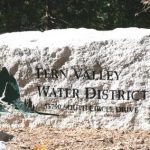What will happen to federal support for homeowner fire abatement? Judging from the words of U.S. Forest Service’s Director of Fire and Aviation Management Tom Harbour at a fire prevention conference last week, we should not expect much in the future.
Last week, a bunch of us from the Mountain Communities Fire Safe Council traveled to Ontario for the conference, which Farmer’s Insurance and the California Fire Safe Council sponsored. We looked forward to hearing Harbour, whose job has him frequently talking to governors and cabinet secretaries, so he is someone to listen to regarding federal support for fire prevention.
The news, not to anyone’s surprise, is not good. He was not exactly blunt, but he did lower expectations about federal funding in the coming years.
This is not to say that wildland urban interface (WUI) communities like ours will be ignored. WUI communities figure prominently in the new National Cohesive Strategy presently being developed and which was the topic of Chief Harbour’s talk. The plan is intended to unite all interested parties in a single, national, fire strategy. (The outline for the plan is already done, and is available at forestsandrangelands.gov.)
The plan lays out three broad goals: restoring resilient landscapes, creating fire adapted communities and providing effective fire response. All three affect us, but the second — creating fire adapted communities — falls directly into the responsibilities of private citizens in fire threatened communities like ours.
“Fire adapted” has not been fully defined as yet, but the basic idea is to create communities that can survive wildland fire with minimal damage and no loss of life.This can be done by property owners creating defensible space around homes and structures by reducing dangerous fuel surrounding the house and “hardening the home” — making the house more resistant to the flaming embers of a wildfire.
Fuel breaks on the periphery of towns make a huge difference in fire safety, but those are generally on federal and state land and the direct responsibility of government agencies, in our case, the Forest Service and CAL FIRE.
We have been fortunate during this last decade. We were spared a great fire such as hit north and south of us in 2003 and 2007. But we reaped the benefits of a large increase in federal funding that allowed a great deal of critical fuels work on our mountain. This money also helped homeowners fire abate their properties in line with defensible space codes. Overall, the money was well spent and our mountain communities are much safer than they were in 2003.
But the funding picture has changed. From now on there is no question that state and federal funding will be tougher to get. Our response as a community should be to continue to make our homes safer with fire abatement and to find ways to make our homes more resistant to embers. (There are low cost ways to do this.)
But we should also continue talking to state and federal leaders about helping the Forest Service and CAL FIRE continue their important fuels work. The best argument we have is in the general truth we all know: prevention is much cheaper than treatment.
If we don’t spend money on reducing fuels on the mountain, if we let all the fuel breaks grow back, the next fire will be very big and very costly, and we will just have to start all over again like we did in 2003.











A fire adapted community is a knowledgeable and engaged community in which the awareness and actions of residents regarding infrastructure, buildings, landscaping, and the surrounding ecosystem lessens the need for extensive protection actions and enables the community to safely accept fire as a part of the surrounding landscape. It is a community-wide effort using wildland urban interface tools such as Firewise, CWPPs, mutual aid agreements, fuels management (inside and outside the community), Ready, Set, Go!, a viable and prepared fire department, evacuation routes or safety zones if evacuation is not feasible, creation and maintenance of external fuels buffers.